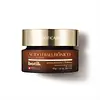What's inside
What's inside
 Key Ingredients
Key Ingredients

 Benefits
Benefits

 Concerns
Concerns

No concerns
 Ingredients Side-by-side
Ingredients Side-by-side

Water
Skin ConditioningDimethicone
EmollientButylene Glycol
HumectantGlycerin
HumectantTrisiloxane
Skin ConditioningTrehalose
HumectantSucrose
HumectantAmmonium Acryloyldimethyltaurate/Vp Copolymer
Hydroxyethyl Urea
HumectantCamellia Sinensis Leaf Extract
AntimicrobialSilybum Marianum Extract
Skin ConditioningBetula Alba Bark Extract
MaskingSaccharomyces Lysate Extract
HumectantAloe Barbadensis Leaf Water
MaskingAloe Barbadensis Leaf Extract
EmollientThermus Thermophillus Ferment
Skin ConditioningCaffeine
Skin ConditioningSorbitol
HumectantPalmitoyl Hexapeptide-12
Skin ConditioningSodium Hyaluronate
HumectantCaprylyl Glycol
EmollientOleth-10
EmulsifyingSodium Polyaspartate
HumectantAloe Barbadensis Leaf Polysaccharides
EmollientLactobacillus Ferment Lysate
Skin ConditioningSaccharide Isomerate
HumectantHydrogenated Lecithin
EmulsifyingTocopheryl Acetate
AntioxidantAcrylates/C10-30 Alkyl Acrylate Crosspolymer
Emulsion StabilisingGlyceryl Polymethacrylate
Tromethamine
BufferingPEG-8
HumectantHexylene Glycol
EmulsifyingMagnesium Ascorbyl Phosphate
AntioxidantCitric Acid
BufferingBHT
AntioxidantDisodium EDTA
Sodium Citrate
BufferingPotassium Sorbate
PreservativeSodium Benzoate
MaskingPhenoxyethanol
PreservativeCI 14700
Cosmetic ColorantCI 19140
Cosmetic ColorantWater, Dimethicone, Butylene Glycol, Glycerin, Trisiloxane, Trehalose, Sucrose, Ammonium Acryloyldimethyltaurate/Vp Copolymer, Hydroxyethyl Urea, Camellia Sinensis Leaf Extract, Silybum Marianum Extract, Betula Alba Bark Extract, Saccharomyces Lysate Extract, Aloe Barbadensis Leaf Water, Aloe Barbadensis Leaf Extract, Thermus Thermophillus Ferment, Caffeine, Sorbitol, Palmitoyl Hexapeptide-12, Sodium Hyaluronate, Caprylyl Glycol, Oleth-10, Sodium Polyaspartate, Aloe Barbadensis Leaf Polysaccharides, Lactobacillus Ferment Lysate, Saccharide Isomerate, Hydrogenated Lecithin, Tocopheryl Acetate, Acrylates/C10-30 Alkyl Acrylate Crosspolymer, Glyceryl Polymethacrylate, Tromethamine, PEG-8, Hexylene Glycol, Magnesium Ascorbyl Phosphate, Citric Acid, BHT, Disodium EDTA, Sodium Citrate, Potassium Sorbate, Sodium Benzoate, Phenoxyethanol, CI 14700, CI 19140
Water
Skin ConditioningDimethicone Crosspolymer
Emulsion StabilisingGlycerin
HumectantCaprylyl Methicone
Skin ConditioningHydrogenated Farnesene
EmollientBiosaccharide Gum-1
HumectantSodium Acrylates Copolymer
PPG-1-PEG-9 Lauryl Glycol Ether
EmulsifyingTocopheryl Acetate
AntioxidantEthylhexylglycerin
Skin ConditioningLecithin
EmollientPhenoxyethanol
PreservativeParfum
MaskingMethyl Methacrylate Crosspolymer
Acrylates/C10-30 Alkyl Acrylate Crosspolymer
Emulsion StabilisingPanthenol
Skin ConditioningTriethanolamine
BufferingHydrolyzed Hyaluronic Acid
HumectantSodium Lauroyl Lactylate
EmulsifyingMaltodextrin
AbsorbentDisodium EDTA
Palmitoyl Tripeptide-5
Skin ConditioningCeramide NP
Skin ConditioningCeramide AP
Skin ConditioningPhytosphingosine
Skin ConditioningCholesterol
EmollientSaponins
CleansingSaccharide Isomerate
HumectantXanthan Gum
EmulsifyingCarbomer
Emulsion StabilisingMineral Salts
Skin ConditioningCI 19140
Cosmetic ColorantCoenochloris Signiensis Extract
Skin ConditioningCeramide EOP
Skin ConditioningBenzyl Salicylate
PerfumingCitronellol
PerfumingGeraniol
PerfumingHydroxycitronellal
PerfumingLimonene
PerfumingLinalool
PerfumingWater, Dimethicone Crosspolymer, Glycerin, Caprylyl Methicone, Hydrogenated Farnesene, Biosaccharide Gum-1, Sodium Acrylates Copolymer, PPG-1-PEG-9 Lauryl Glycol Ether, Tocopheryl Acetate, Ethylhexylglycerin, Lecithin, Phenoxyethanol, Parfum, Methyl Methacrylate Crosspolymer, Acrylates/C10-30 Alkyl Acrylate Crosspolymer, Panthenol, Triethanolamine, Hydrolyzed Hyaluronic Acid, Sodium Lauroyl Lactylate, Maltodextrin, Disodium EDTA, Palmitoyl Tripeptide-5, Ceramide NP, Ceramide AP, Phytosphingosine, Cholesterol, Saponins, Saccharide Isomerate, Xanthan Gum, Carbomer, Mineral Salts, CI 19140, Coenochloris Signiensis Extract, Ceramide EOP, Benzyl Salicylate, Citronellol, Geraniol, Hydroxycitronellal, Limonene, Linalool
 Reviews
Reviews

Ingredients Explained
These ingredients are found in both products.
Ingredients higher up in an ingredient list are typically present in a larger amount.
Acrylates/C10-30 Alkyl Acrylate Crosspolymer is a synthetic polymer. It is used to thicken and improve the texture of products. Due to its properties, it can prevent water and oil ingredients from separating.
CI 19140 is also known as Tartrazine. Tartrazine is a synthetic dye used in cosmetics, foods, and medicine to add a yellow color.
Tartrazine is created from petroleum and is water-soluble.
Some people may experience allergies from this dye, especially asthmatics and those with an aspirin intolerance.
Learn more about CI 19140Disodium EDTA plays a role in making products more stable by aiding other preservatives.
It is a chelating agent, meaning it neutralizes metal ions that may be found in a product.
Disodium EDTA is a salt of edetic acid and is found to be safe in cosmetic ingredients.
Learn more about Disodium EDTAGlycerin is already naturally found in your skin. It helps moisturize and protect your skin.
A study from 2016 found glycerin to be more effective as a humectant than AHAs and hyaluronic acid.
As a humectant, it helps the skin stay hydrated by pulling moisture to your skin. The low molecular weight of glycerin allows it to pull moisture into the deeper layers of your skin.
Hydrated skin improves your skin barrier; Your skin barrier helps protect against irritants and bacteria.
Glycerin has also been found to have antimicrobial and antiviral properties. Due to these properties, glycerin is often used in wound and burn treatments.
In cosmetics, glycerin is usually derived from plants such as soybean or palm. However, it can also be sourced from animals, such as tallow or animal fat.
This ingredient is organic, colorless, odorless, and non-toxic.
Glycerin is the name for this ingredient in American English. British English uses Glycerol/Glycerine.
Learn more about GlycerinPhenoxyethanol is a preservative that has germicide, antimicrobial, and aromatic properties. Studies show that phenoxyethanol can prevent microbial growth. By itself, it has a scent that is similar to that of a rose.
It's often used in formulations along with Caprylyl Glycol to preserve the shelf life of products.
Saccharide Isomerate comes from sugars found in corn. It is a skin hydrator.
The structure of this ingredient can be altered to be more similar to the carbohydrates found in our skin. This ability to mimic our skin gives it hydrating properties.
Specifically, saccharide Isomerate is a humectant. Humectants draw moisture from the air to our skin.
Research shows Saccharide Isomerate to be an effective moisturizer.
Learn more about Saccharide IsomerateTocopheryl Acetate is AKA Vitamin E. It is an antioxidant and protects your skin from free radicals. Free radicals damage the skin by breaking down collagen.
One study found using Tocopheryl Acetate with Vitamin C decreased the number of sunburned cells.
Tocopheryl Acetate is commonly found in both skincare and dietary supplements.
Learn more about Tocopheryl AcetateWater. It's the most common cosmetic ingredient of all. You'll usually see it at the top of ingredient lists, meaning that it makes up the largest part of the product.
So why is it so popular? Water most often acts as a solvent - this means that it helps dissolve other ingredients into the formulation.
You'll also recognize water as that liquid we all need to stay alive. If you see this, drink a glass of water. Stay hydrated!
Learn more about Water